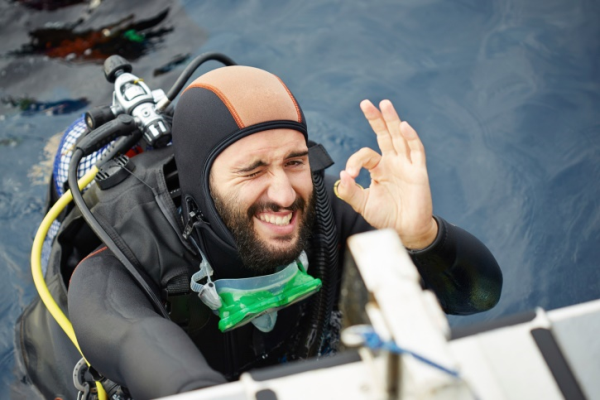 Scuba diving opens your eyes to a whole new world and is an immensely rewarding adventure. However, for the novice diver a lack of experience and scuba technique can prevent you from fully enjoying the dive. Some of the most common problems faced include not adapting well to the changes in pressure, confusion in water or even weak swimming skills. Nevertheless, far and by the most important factor that can influence a novice diver’s experience is breath control while diving. Rapid or shallow breathing will reduce the amount of time you get to enjoy your dive because you reach the maximum amount of time per tank more quickly. There are various factors that influence the divers breathing, notably nerves, technique and respiratory health. Nerves will calm with experience whilst technique and respiratory strength can be improved through training. To condition your lungs for a better diving experience you should consider breathing exercises and respiratory muscle training devices.
Scuba diving opens your eyes to a whole new world and is an immensely rewarding adventure. However, for the novice diver a lack of experience and scuba technique can prevent you from fully enjoying the dive. Some of the most common problems faced include not adapting well to the changes in pressure, confusion in water or even weak swimming skills. Nevertheless, far and by the most important factor that can influence a novice diver’s experience is breath control while diving. Rapid or shallow breathing will reduce the amount of time you get to enjoy your dive because you reach the maximum amount of time per tank more quickly. There are various factors that influence the divers breathing, notably nerves, technique and respiratory health. Nerves will calm with experience whilst technique and respiratory strength can be improved through training. To condition your lungs for a better diving experience you should consider breathing exercises and respiratory muscle training devices.
The Benefit of Breathing Exercises and Respiratory Muscle Training Devices
Deep breathing exercises such as those used in yoga have been proven to improve lung efficiency. Though no product or technique can improve lung capacity, the physical size of your lungs, what can be improved is the capability to use your lungs, usually measured as the amount of air per breath. There are various deep breathing methods you can experiment with, but at a basic level inhaling and exhaling slowly and deeply to a count of 4 is a good place to start. The trick is to relax your abdomen when you inhale to allow your lungs to fill and contract (squeeze in) when you exhale to and exhale fully and completely.
Another effective method for improving your lung function is to splash cold water on your face whilst holding your breath. This triggers your brain to prepare to dive underwater and as a result has been proven to activate the slowing of your heart rate. Heart rate regulation is key to passing oxygen effectively through your blood stream and maintaining an equilibrium. Keep the water cool, not icy, as this will induce hyperventilation and defeat the purpose of the exercise.
Deep breathing exercises are effective, however when you begin to tire you will slow down though you will continue to take air in. The problem is that you will be unable to use the muscles at the same level of intensity and as such will not get the same amount of training with each breath. In order to get the greatest benefit out of breathing exercises, a respiratory muscle training device is advisable. PowerLung provides an adjustable resistance, which ensures that you continue to receive the same intensity per breath even as you tire. It works by providing resistance to the user’s natural breathing pattern. This will assist you in building stronger, more effective lungs, in as little as 10-minute daily workouts.
The benefits of PowerLung where outlined in a study from Barry University. In this study participants underwent a 5-week respiratory muscle training program in which 3 sets of 10 breaths where performed twice a day. Those who used the respiratory device saw improved heart rate response during physical activity, improved vital capacity and improved air consumption during a 3-minute fin kicking drill. These overall physiological benefits are immediately transferable to scuba diving and the results indicate an improved bottom time for divers.
Ultimately, conditioning your lungs is a key part of the scuba diving process. A consistent daily training program, in which you utilize both basic breathing exercises and a respiratory training device such as PowerLung, is the best way to improve your lung function in quick time.

